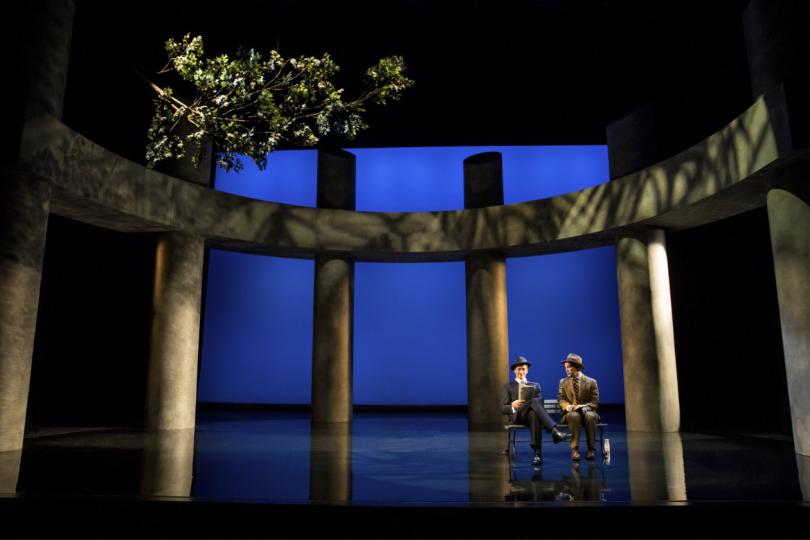How far we've come, how far we've yet to go.

This is an amazing time to be alive. I’m not saying this is the best time to be alive but I’m absolutely saying it’s the most interesting. The changes I’ve seen in my 32 years have been more profound than hundreds and thousands of years in other eras. The cultural shifts that are part of our daily lives are the stuff of future legend. I’m not saying the same amount of progress and regress haven’t happened in other times but living now we have the tools (the recordings, the newspaper articles, the youtubes) to directly reference the past and see that the times, they still are...and aren’t…a changin’. We have the source material at our fingertips and though that hasn’t destroyed hypocrisy or defiance of guilt, it has made statements of fact irrefutable. IRREFUTABLE. That’s a word we could discuss all day, but not this day.
On this day I convey to you a beautiful experience I had. A perfect creation I witnessed. A critical yet optimistic view of our history and, innately, who we are. I’m here to tell you about MN Opera’s production of Fellow Travelers, a 2-year old opera telling the tale of an overlooked period of our recent American history. No clearer introduction could be given to this tale than the program notes written by director Peter Rothstein:
“In 1953, President Eisenhower signed an Executive Order declaring that homosexual women and men were to be labeled “sexual deviants” and were banned from working in the U.S. government. It became known as the Lavender Scare. More than 5,000 men and women working at home and abroad lost their jobs with the U.S. government and were publicly outed. As a result, they were ostracized, not only from their employers, but also their families and their government. Many took their own lives; although one could argue their lives had been taken from them.”
This is the same era as the Communist ‘Red Scare’ with the same Senator McCarthy at the helm. Much has been said of the Red Scare; I’ve seen interviews with Leonard Bernstein speaking of its horrors and idealist Pete Seeger citing his 1st Amendment rights when everyone else was pleading the 5th. Arthur Miller’s classic play The Crucible was written as a direct allegory to the proceedings of the times: the figurative witch-hunt in Washington D.C. was dramatized as a literal witch-hunt in Salem, Massachusetts. While much has been said of the Red Scare, I’ve never heard the term ‘Lavender Scare’ until this week. And why is that? Because more people (certainly more famous people) were affected by Red than Lavender? Perhaps. Because newspaper writers and TV news anchors have an easier time talking about Red than Lavender? Perhaps. Because it’s easier to argue that a person has a right to their chosen political beliefs than it is to argue that a person has a right to their innate sexuality? Perhaps.
But I digress… Back to Saturday night:
The Cowles Center on Hennepin Avenue is a delight. I’ve heard it mentioned as a dance venue for years but upon my first time inside I was shocked at its size. It’s a full proper theater with a balcony, an orchestra pit, a fly space, and an enormous stage. This very approachable opera (with its orchestra of 17 and cast of 9) did not fill the space to the brim but luxuriously made it its home. The opening scene is the most charming and expressive thing you’ve ever seen. In perfect lighting we see a Washington D.C. park complete with both gentle foliage and imposing concrete. We see a baby-faced man drinking milk in the park as innocent as a lamb. Another man enters and the audience, along with both characters, slowly figures out that he is more shepard than wolf. It’s a love story. They want to start being in love so they start being in love. Not even the cherry blossoms are more natural than that.
In case the story, the scenery, and the 1950s winks aren’t enchanting enough there’s also the music. From the first notes the composition is gentle and lovely. Hearing this music feels like floating for two hours straight, then eventually being placed back lightly on the ground. The style feels closer to Nico Muhly than to anything from past centuries and the work (as with almost all contemporary operas I’ve seen) is entirely through composed. With no noticeable musical repetition, you won’t leave the theater humming any of the melodies but you will remember the way they made the scenes feel.
With a masterful cast, every character was likable and focused in a way that perfectly suited the narrative (I even liked to dislike the bad guys). Each of the seven non-lead characters played their roles with mastery; commanding attention when needed and blending into the ensemble on command. Out-of-town talent Hadleigh Adams is a masterful actor who uses his profound voice to direct the emotion of each scene. And let’s talk about Andres Acosta… this young tenor has been a resident artist with MN Opera all season and has played small roles in every show this year. And praise all that is holy, he’s finally been given the leading role! From his sheepish and delicate opening scene to his existential-crisis-turned-to-art-aria in the church pew, he excelled at every demand placed upon him. More Andres please. Also, it should be noted that this is the most racially diverse cast BY FAR that I’ve seen on a MN Opera stage. Whether by chance, intentionally, or at the hand of director Peter Rothstein I do not know. Whatever the case, it was a beautiful experience to see actors on stage who look like the world around me and not like the court of long-dead European aristocrats for whom many operas were written. BRAVO!
I hate reviews that spoil the plot so I won’t do that here (JUST GO SEE IT!) but I will allude to one moment of interest. In a ‘morning after’ scene, little lamb Tim goes to his church where we see his devout faith wrestle with his newfound sexuality. In essence… whether ‘tis nobler to trust the culture in which he was raised or to his own self be true. This is a fundamental question of the opera and (if you’ll go on a brief tangent with me) of this weekend’s Twin Cities Pride Festival and much else of what our nation is going through in 2018. How do we come to terms with the world we’ve inherited and also stay true to ourselves? Do we throw the proverbial baby out with the bathwater and condemn all our social structures? Do we stare boldly into our problematic past? I love the way this opera handles these questions…it approaches them boldly from multiple perspectives and doesn’t claim to answer any but does imply that they can be answered. Tim’s solo aria in church was magic. On opening night it was greeted with thunderous applause that threatened to stop the show in its tracks. The ovation was certainly earned by Mr. Acosta but at least part of my clapping was for the idea that these big questions can be raised and talked about with 499 strangers. This overt challenging of our cultural past stands in stark contrast to Arthur Miller’s Crucible of 1953. Miller had to use allegory to talk about the Red Scare, presumably because in his era it wasn’t acceptable to boldly state un-popular facts or opinions. Fellow Travelers deals with the same era, the same McCarthy, and the same persecution but has a wildly different tone. It doesn’t need allegory. It states facts (or at least plausible historic fictions - more on that in a second) and boldly uses the real names of real senators. At the very least, this directness gives me hope for our country that we no longer need veiled allegory to talk about the mistakes of the past. At rock bottom, let’s discuss past events openly (and accurately) and move on from there.
Now about that historical fiction… I’d like to take this moment to coin a phrase: *clears throat* “The Hamilton Effect”. The Hamilton Effect is when Brian Lenz loves Lin-Manuel Miranda’s musical Hamilton for many years and then incorrectly assumes all new works on stage are detailed factual accounts of history. I, Brian Lenz, experienced The Hamilton Effect on Saturday night. I was dumbfounded at the coincidence that the speechwriter for U.S. Senator Charles E. Potter (a central figure in the McCarthy hearings) was a gay man who was outed and fired during the Lavender Scare. I was amazed that Hawkins Fuller was such a prominent part of this era and I’d never heard his name before. Of course I now know that Fellow Travelers (while based on actual events) is a work of fiction. Novelist Thomas Mallon published the novel in 2008 (before it was adapted into an opera in 2016) and says of the 2 main characters “Fuller and Laughlin aren't based on any particular historical figures. Both contain bits and pieces of people I've known in my own life, which makes them like the characters one finds being created by just about any novelist of the "non-historical" sort.” The Hamilton Effect strikes again. Of course this makes the actual historical facts no less true or the moral questions no less urgent, but it softens the edges and makes me realize I know even less about the actual facts of this era than I thought.
Mallon also said “In this regard, though, one thing in particular interested me about Laughlin. When I started to make notes on him, the first thing I put down was "Date of birth: November 2, 1931"– exactly twenty years earlier than mine. I realized that in some ways I was going to be writing about what my own life might have been like had I been born two decades earlier.” I LOVE THAT! While this opera and book aren’t about specific people, they are specifically the empathetic imaginations of Thomas Mallon… A thought experiment about how your life would be different if nothing changed except your circumstances. If you enjoy thoughts and empathy and good singing go check it out.




